The long tailed tit is one of the UK’s most sociable common garden birds. Widespread across the country, long tailed tits brighten up many of our gardens. But how much do you know about the long tailed tit? Because there’s plenty to learn! For example, did you know that long tailed tits are a cooperative breeding species? Or that they only live for an average of 2 years? There’s plenty more to discover!
If flocks of these noisy birds populate your garden, why not take some time to learn more about them? Here are our essential facts and information on the long tailed tit, one of the UK’s most loved garden birds.
Long Tailed Tit Facts

Scientific Name: Aegithalos Caudatus
Size: 14 cm
Weight: 7 – 10 g
Wingspan: 16 – 19 cm
Wild Food: Insects, larvae, spiders, seeds
Clutch Size: 6 – 9 eggs
Egg Size: 14 x 11 mm
Egg Weight: 0.9 g
Nesting Season: April – July
Lifespan: 2 years
Conservation Status: Green[i]
Identifying Features of A Long Tailed Tit

You won’t struggle to identify a long tailed tit! They have beautiful black and brown upperparts, white underparts and distinctive pink plumage across their round breast. They also have brown-white cheeks and small orange rims around the eyes. The long tail that gave them their name is slightly larger than their body and lined with black feathers on top and white underneath.
Juvenile long tailed tits look only slightly different. Rather than white cheeks, a young long tailed tit has a black face to match the rest of its body.
What Does A Long Tailed Tit Sound Like?
The long tailed tit is an infamously noisy bird, and they call out to each other regularly. As long tailed tits tend to stay in flocks, they make regular vocalisations to keep in touch with members of their family.
A long tailed tit call is easy to distinguish. It usually begins with a succession of high-pitched whistles, sounding something like a ‘tsee-tsee-tsee’ sound. Often, they follow this whistle with rattly shouts, which can be difficult for us to hear.
What Do Long Tailed Tits Eat?
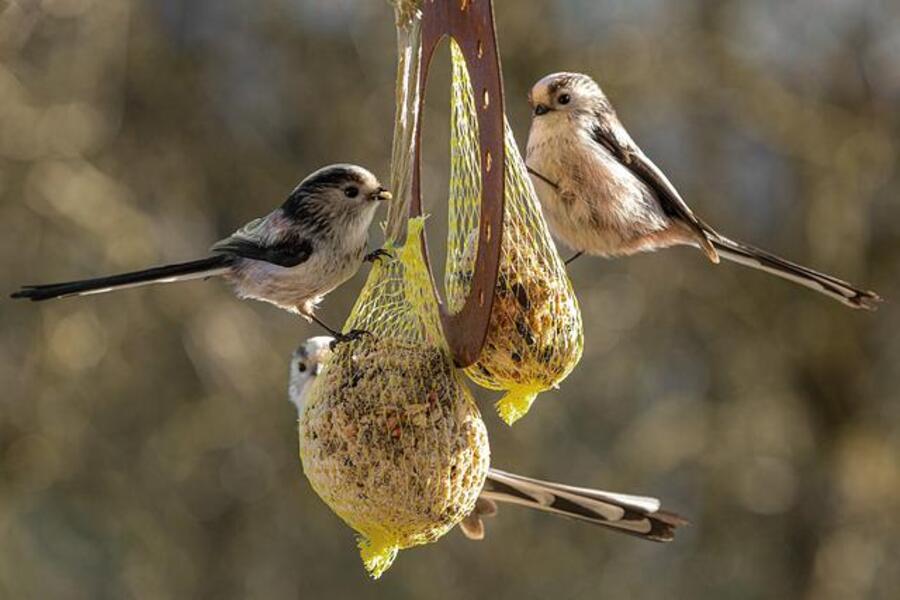
Long tailed tits favour insects and invertebrates, such as spiders and caterpillars in the wild. During winter, they may also snack on stray seeds and fruit.
Since long tailed tits are only small birds, they love heat more rapidly than their larger relatives. Because of this, periods of harsh cold weather can leave them vulnerable. Additionally, the small long tailed tit isn’t able to carry around food reserves regularly since they will slow them down if they have to make a quick getaway.
Long tailed tits need access to reliable sources of high-energy foods during winter to survive the harsh weather. Hence why they will snack on seeds and fruit during this time. Also, this is when you may see an increase in long tailed tits visiting your garden. Make sure to leave out energy-rich foods, like fat balls, during winter to keep long tailed tits energised.
Long Tailed Tit Nesting Habits

Long tailed tits are often relatively early nest builders. People have spotted them beginning to build their nests as early as February, although their breeding season doesn’t usually start until mid-April. It ends in late July. If you’re lucky, you may spot wannabe nesters searching for a suitable nesting spot above vegetation and similar densely packed landscapes.
During their breeding season, long tailed tits will only have 1 or 2 clutches of around 6 – 9 eggs. However, unlike other birds, long tailed tits remain sociable during their nesting season. Although individual pairs will work to raise their own young, if they are unsuccessful, they will lend a hand to nests of close relatives instead. This is known as cooperative breeding and explains why long tailed tits only have one or two clutches each year.
What Does A Long Tailed Tit Nest Look Like?

Long tailed tits prefer to nest in trees and will not be attracted to nesting boxes. Instead, they construct their intricate nests in a unique bottle shape, usually high up in the fork of a tree. A long tailed tit uses moss, lichen and spider webs to create a nest that uses the silky webs to grow and stretch. This way, the nest will accommodate the chicks as they hatch.
Other than tree branches, you may find the nest of a long tailed tit amongst dense vegetation, particularly shrubs and bramble bushes.
How To Identify Long Tailed Tit Eggs
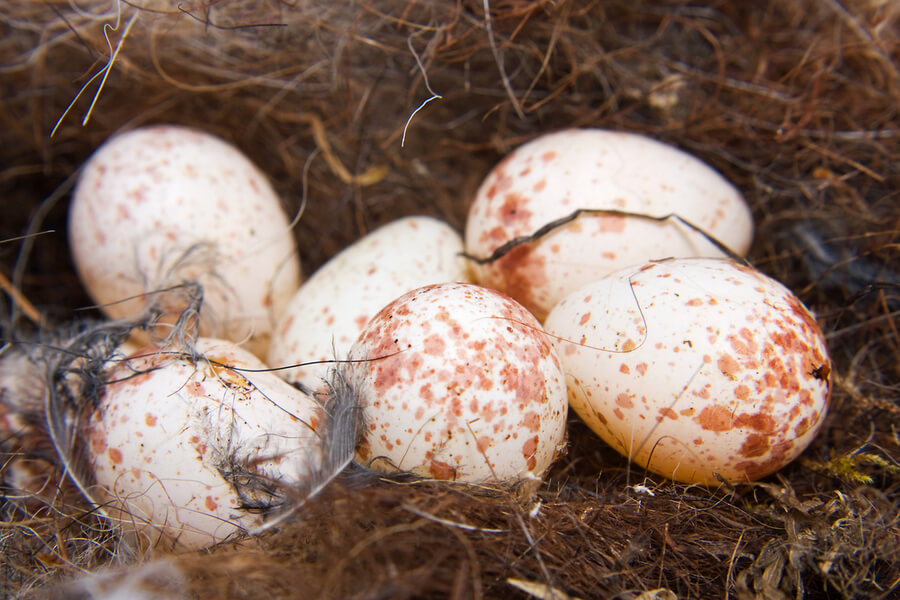
Long tailed tit eggs are similar to those of the great tit (which, surprisingly, long tailed tits aren’t that closely related to). They are a glossy white with faint purple-brown markings. They are relatively small and fragile, measuring around 14 x 11 mm and weighing just less than a gram.
Once the female has laid the eggs, it can take 12 – 14 days for them to hatch. The fledglings will leave the nest a further 14 – 18 days after. Although long tailed tit fledglings may set out on their own, it’s not uncommon for them to stay with their parents and relatives in their flock.
Identify more bird eggs with our bird egg identification guide.
How Many Long Tailed Tits Are There In The UK?
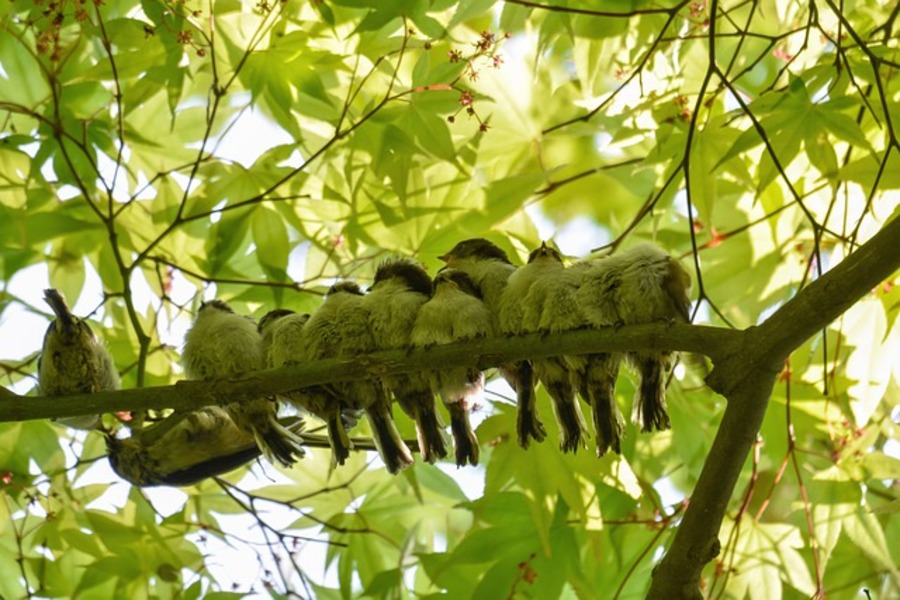
Long tailed tits are one of Britain’s most common birds. There are an estimated 380,000 breeding pairs spread over 340,000 territories all across the country. Unlike other garden birds, the long tailed tit has seen an increase in population numbers since the mid-1980s, rather than the decline that many others have faced. It’s because of the species’ increase that they remain on the green list of the Birds of Conservation Concern report.
Despite their popularity around the country, long tailed tits don’t currently live in the far north or west of Scotland. This is likely because it’s too cold for them there.
How To Attract Long Tailed Tits To Your Garden
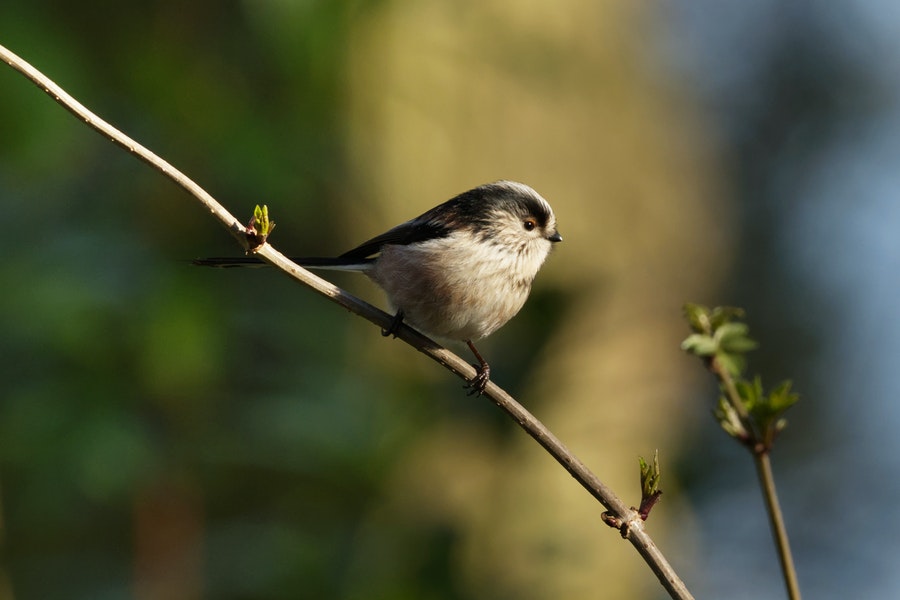
The long tailed tit is a common garden bird around the UK – chances are, you already have some visiting you! But, if you’re not seeing them on your property, there may be something going on. So here are some tips on attracting (and keeping) long tailed tits in your garden.
- Leave Out Their Favourite Foods – Long tailed tits have a particularly varied diet and will happily eat many foods you leave out. However, some of their favourites that are guaranteed to disappear are dried mealworms, peanuts and suet blocks.
- Provide Water – Fresh water is vital to any bird. They need it to keep hydrated and wash themselves, particularly during extreme weather when natural sources are scarce. Fill a bird bath with some fresh and change the water regularly.
- Grow Some Bushes and Tall Trees – The long tailed tit won’t nest in nesting boxes; they prefer to make their home in trees and bushes. So, grow some! Thorn bushes are a particular favourite of long tailed tits, specifically hawthorn bushes.
- Protect Them From Predators – All birds will abandon your garden if they sense a predator is near. So, if your garden is bare of birds altogether, you may have a predator stalking the area. Take precautions to block any predators from entering your garden and protect any visiting birds.
- Avoid Using Chemical Pesticides – Long tailed tits enjoy feeding themselves and their young insects. Any chemical products you use in your garden can cause less insects and potentially even harm the birds. Try and find some natural alternatives – your garden and its wildlife will thank you!
- Clean Up – Washing bird feeders, bird baths and other apparatus that birds use regularly is vital. Leaving them unwashed can have several detrimental effects, including the build up of mouldy bird food and the spread of potentially fatal diseases between birds. Clean your feeders and baths every couple of weeks to keep birds safe and happy in your garden.
Looking After The Long Tailed Tits
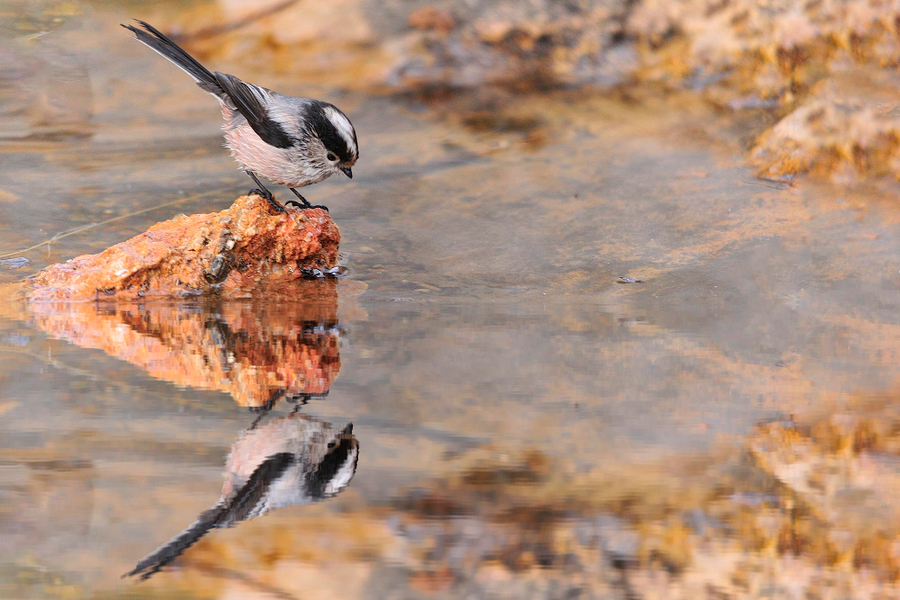
Long tailed tits have been a common visitor to our gardens for many years. In fact, they seem to enjoy many of our urban atmospheres since our gardens are rich with food sources and safe places to shelter. And now, when you spot these joyous, inquisitive birds in your garden, you’ll know just why they’re there and how you can keep them around!
Do you have any fun facts about the long tailed tit? Are some of these beautiful birds visiting your garden at the moment? Tell us about your experiences in the comments.
Sources
[i]https://www.wildlifetrusts.org/wildlife-explorer/birds/tits-crests-and-warblers/long-tailed-tit
Gemma Sharp is the resident writer for Love Garden Birds, a supplier of premium bird food and accessories. She has had a genuine love for our feathered friends from a young age, and has dedicated a lot of her time to learning all there is to know about them. If you’re struggling to pick the right bird feed for your garden, need help identifying a type of wild bird, or can’t decide where to put a nesting box, Gemma is the person to go to! She is passionate about sharing her years of learnt knowledge with the public. In her free time, she can be found feeding birds at home with her three young boys.



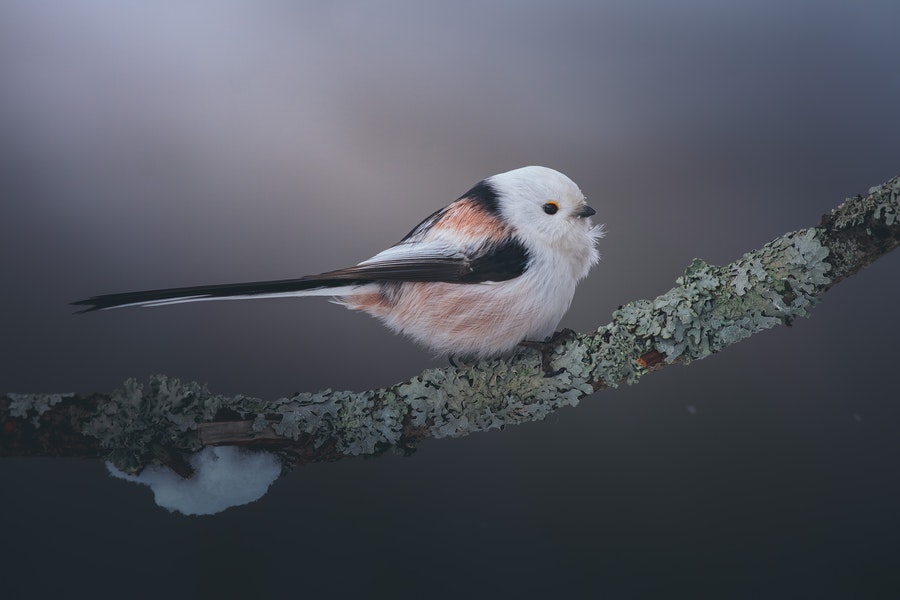
Hello Gemma
We live in southern Croydon, and have a fairly secluded back garden with bushes and small trees around the perimeter (and bigger trees not far away). We have regular robins, blue tits, house sparrows, collared doves, wild pigeons and annoying green parakeets. Not far away and occasional drop-ins are starlings, blackbirds, magpies. Less common are goldfinches (though we did have one bumper year), great tits, hedge sparrows etc. One year we had coal tits and another winter, redwings. And very rare are the long-tailed tits. But one came today (27.01.24); however, maybe because it was alone, it was mobbed by the jealous blue tits, and scared off. We have peanuts, fat balls and mixed seeds, all of which should attract long-tailed tits. My question is why should the blue tits be jealous and how else can we attract the long tailed variety? Thank you